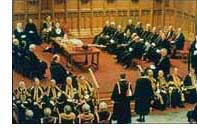 Its constitution rooted in the ancient rights and privileges
enjoyed by citizens before the Norman Conquest in 1066, the City of
London developed a unique form of government which finally emerged
as the first independent local authority in Britain.
Its constitution rooted in the ancient rights and privileges
enjoyed by citizens before the Norman Conquest in 1066, the City of
London developed a unique form of government which finally emerged
as the first independent local authority in Britain.
The right of the City to run its own affairs was gradually won
as concessions were gained from the Crown. London's importance as a
centre of trade, population and wealth secured it rights and
liberties earlier than other towns and cities. From medieval to
Stuart times the City was the major source of financial loans to
monarchs, who sought funds to support their policies at home and
abroad.
That London enjoyed certain freedoms and had a form of civic
administration before the Norman conquest, can be seen in the
Charter granted by William the Conqueror in 1067, in which he
promised to recognise the rights, privileges and laws that the City
had enjoyed since the time of Edward the Confessor (1042-66).
In Saxon London and in the medieval period, municipal authority
rested principally with Aldermen ('elder' men), who met in the
City's ancient Court of Husting - the supreme court of the medieval
City, with administrative and judicial functions. There is reliable
evidence of its existence in 1032, although it was probably much
older, and by the mid-12th century it was held weekly. It is likely
that the Court of Aldermen developed from the administrative side
of the work of the Court of Husting.
London, like other cities, was subject to the authority of the
Crown through its Sheriff - the Shirereeve or Portreeve. But in the
12th century, as a move towards civic independence, an association
of citizens under oath - the commune - was established. At the same
time the office of Mayor was created with Henry FitzAilwyn
taking office in 1189 (whether by appointment or election is
unclear).
In 1191, the commune was officially recognised by Prince John,
while his brother Richard the Lionheart was away at the Crusades,
and in 1199 John, now King, granted the citizens of London the
right to elect their own Sheriffs - a particularly significant
right as the Sheriff was the King's representative through whom the
City was governed. The citizens' right to elect a Mayor annually
was granted by King John in a charter of 1215.
The commune may have been the origins of the development of
another element of local government in the City. Gradually,
Aldermen began to summon "wise and discreet" citizens from their
wards to their meetings for consultation on particular matters. In
1285, a group of 40 citizens, between one and four from
each Ward, was to consult with the Aldermen on the common affairs
of the City. From 1376, this assembly had regular meetings and was
known as the Common Council. It gradually assumed greater
responsibilities and the business of the Court of Aldermen
declined.
Today the
Court of Common Council is the 'town council' of the City of
London. Its work includes both the work of an ordinary local
authority council and that arising from its historical status and
tradition. It works through committees, like any other local
authority, but it is unique in that it is non-party political.
Since 1384, Common Council has been elected by the wards of the
City. Elections are held every four years in March when all the
seats are up for re-election. Each of the wards returns between two
and ten members, depending on the size of the electorate.
Candidates, men or women, must be
freemen of the City and on the electoral roll of the City of
London. Common Council members are also known as Commoners.
Common Council, presided over by the Lord Mayor, meets every
fourth Thursday in the Great Hall of Guildhall at 1.00pm. On
ceremonial occasions and at the first meeting of a new Mayoralty,
Common Councilmen wear fur-trimmed gowns of deep blue
silk.